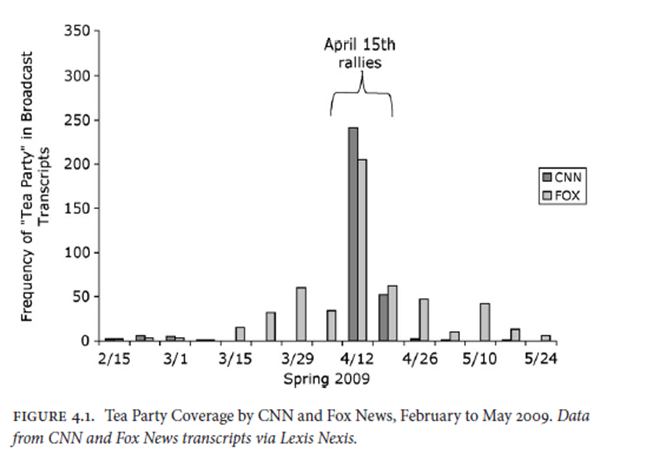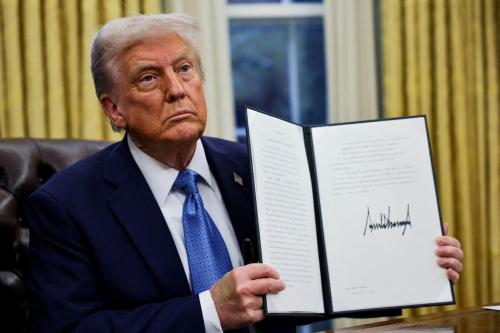In mid-February, thousands of people across the United States mobilized in opposition to President Trump and Elon Musk’s attempts to bring nonpartisan and independent government institutions under their personal control. These demonstrations received substantial coverage in major media, as have recent town hall meetings at which constituents have demanded action from their representatives in Congress. This turnout and coverage were undoubtedly gratifying to organizers, but the nascent movement is not yet supported by a media infrastructure adequate to build long-term momentum.
To see how the press can mobilize and shape dissent, we need not look further than 2009. Within months of President Obama’s first inauguration, grassroots conservatives were mobilized through a powerful conservative media. The very earliest protests against Obama’s economic stimulus were small and lacked a unifying symbolism—until conservative radio hosts, adopting an impromptu rant by a CNBC host proposing a new “Tea Party” in Chicago, organized protests under this new banner. Fox News soon joined in, encouraging their viewers to attend Tea Party events and even broadcasting their programs from Tea Party rallies.
As sociologist Theda Skocpol and I wrote in our first article on the Tea Party movement, “conservative media have played a crucial role in forging the shared beliefs and the collective identity around which Tea Partiers have united.” This kind of coverage was both qualitatively and quantitatively different from traditional media attention. As you can see in the figure below, drawn from our 2012 book, CNN coverage matched Fox News during protest events. But Fox News’ coverage preceded the protests and continued thereafter.
In covering the protests both before and after they occurred, Fox News played a key role in the Tea Party’s development. Most obviously, the channel informed their viewership of the upcoming protests, so that they could participate. But the coverage also legitimated protest as a strategy, a significant factor for their older, conservative audience. The heavy media attention also made the protests seem large and important, helping overcome the collective action problems that bedevil social movements. Finally, media coverage helped turn the protestors’ political and social grievances into a coherent political message.
Particularly given the fragmented media environment and the continued dominance of social media platforms owned by administration officials and allies, Trump’s opponents are particularly in need of a media platform to perform the kinds of mobilization that Fox News provided to the Tea Party.
Of course, the American left lacks the coherent media infrastructure that exists on the right. Many mainstream outlets see their role as triangulating between the left and the right, even as they come under direct attack for evidence-based reporting that challenges the administration. Elon Musk, for example, recently stated that CBS News’ 60 Minutes reporters “deserve a long prison sentence.” One major challenge is the chilling effect that may come from the administration’s efforts to punish media outlets for negative coverage and to threaten political opponents with political retribution.
Nonetheless, major news outlets continue to cover executive aggrandizement by the administration. In addition, a number of smaller outlets—including the Bulwark, Heather Cox Richardson’s Letters from an American, and the Contrarian—have defined themselves in opposition to the actions of the current administration. (Certainly, these outlets lack the reach of Fox News, but research suggests that even relatively small protest movements can be highly effective.) But while many in the media are documenting and even decrying the actions of the administration, they are not yet providing sustained attention to the grassroots opposition, much less the kind of mobilizing support conservative movements have relied upon.
If that pattern were to shift, what would we expect to see? Regular and rising coverage in advance of major protest events and lingering coverage thereafter. Portrayal of protests as enjoyable social gatherings, evoking hope that participants can achieve their goals. Interviews with protestor organizers. Human interest stories about protest participants, and survey analyses of their demography and their concerns. For outlets that have taken a clear position against the administration, active participation in demonstrations by their prominent media figures.
Polling averages demonstrate that Trump’s net approval rating is dropping. But politics is not a public opinion poll. Whether widespread but nebulous opposition to the administration can be organized into effective political action depends, to a substantial extent, on how media covers the weeks to come.
The Brookings Institution is committed to quality, independence, and impact.
We are supported by a diverse array of funders. In line with our values and policies, each Brookings publication represents the sole views of its author(s).









Commentary
How will the media cover protests against President Trump and Elon Musk?
February 28, 2025